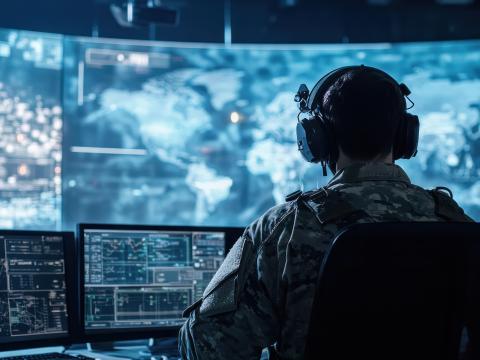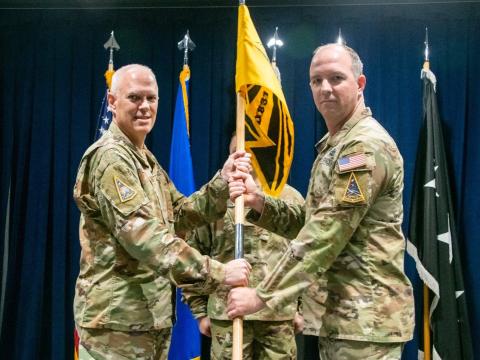Air Power in the Indo-Pacific Looks To Go Full Throttle
Twenty-two months of planning came to fruition for the Pacific Air Forces (PACAF) during this summer’s groundbreaking REFORPAC, or Exercise Resolute Force Pacific 2025.
The exercise harnessed 400 international aircraft and 12,000 warfighters and put air power assets across 50 locations in the vast Indo-Pacific in a single week, reported Lt. Gen. Laura L. Lenderman, USAF, deputy commander of Pacific Air Forces and deputy theater air component commander to the commander of U.S. Indo-Pacific Command.
“This massive effort required a strategic shift that depended on reliable and seamless connectivity, bolstering PACAF’s ability to protect power and share information even in contested and disconnected environments,” Lenderman stated.
Lenderman spoke Wednesday at AFCEA’s TechNet Indo-Pacific conference in Honolulu, Hawaii, sharing her observations and those of her boss, Gen. Kevin Schneider, USAF, commander, Pacific Air Forces.
PACAF embarked on this “first-in-a-generation department-level” exercise to shore up air power with U.S. allies and partners across the region that spans 4,000 miles north to south by 6,000 miles east to west and is considered a contested, adversarial environment where communications are disrupted, degraded, intermittent or at the very best, limited.
“REFORPAC [was a] series of nested, phased effort that we executed this summer to test and stress our schemes of maneuver,” the deputy commander explained. “It encompassed multiple commands and multiple areas of operations. It tested airmen and guardians’ ability to conduct sustained, complex military operations involving large numbers of forces and situations where we contested air and space superiority, power projection and global mobility.”
In addition to working with all branches of the U.S. military, the exercise included the nations of Australia, Japan, Canada, South Korea, New Zealand and the United Kingdom.
“These partnerships were not transactional,” she stated. “They were forged through collaborative planning, fostering trust and shared understanding. This meant deep integration and interoperability, ensuring seamless coordination from initial concept to final execution.”
Lasting six weeks, REFORPAC encompassed incredible logistics and movement of airmen, fuel, weapons, equipment and spare parts.
“Over the course of almost six weeks, we ensured we could transfer fuel, weapons, equipment and parts to the right place at the right time to build combat power, proving that we know how to generate air power at the time and place of our choosing, even from incredibly long distances, just like our grandfathers did, from Tinian, Saipan, Guam and Palau over 80 years ago,” Lenderman emphasized, referencing the demands of the end of World War II.
Phase A of the effort featured the rapid movement of international aircraft and forces “exploding” into the theater in a week.
The forces established forward logistics nodes, delivered integrated expeditionary command and control (C2) capabilities and orchestrated air power from the mainland throughout the Indo-Pacific at a rapid speed and scale.
Within the U.S. Air Force’s own major commands, PACAF had to work closely with Air Mobility Command as well as the U.S. Transportation Command, the lieutenant general said.
Phase B of the REFORPAC exercise involved establishing fighting positions in the first and second island chains.
“Our regional air defense commands in Japan and Guam were able to test, refine and demonstrate our ability to quickly synthesize sensor data from multiple airborne-, space- and sea-based platforms and provide a rapid joint response to enemy threats in virtual, constructed and live fly environments,” she noted.
Expeditionary communication packages had to be deployed across the theater to ensure that the Air Force commander of forces, the theater’s Joint Force Air Component commander and the Air Defense commander could communicate and execute their authorities.
This was done across two air expeditionary task forces, five air expeditionary wings and an air task force in the first and second island chains, Lenderman said.
This phase was also a great test of the dispersed C2 needed for the Air Force’s modern-day operational approach of agile combat employment—launching, recovering and maintaining aircraft from dispersed forward-operating locations, with allies and partners.
As such, PACAF leaders were able to clearly see the communications and coordination challenges not necessarily seen under normal operating conditions and to consider how more effective C2 should be deployed in the Indo-Pacific.
Over the course of almost six weeks, we ensured we could transfer fuel, weapons, equipment and parts to the right place at the right time to build combat power.
“This focus drives questions such as, do we have the right people, do we have enough people, and where do they need to be, where do the C2 nodes need to be established?” Lenderman said. “And what are the pipes, pathways and infrastructure that we need to be able to command and control across the joint force and with our allies and partners and in terms of processes? These are the questions that we asked during REFORPAC, and we continue to focus on today.”
In addition, REFORPAC featured the use of emerging technologies, including tools that enabled multidomain kill-chain methodology and autonomy.
“In one instance, we were able to collect data on targets from operators in forward locations and send it back to our air operation center (AOC) using a commercial-off-the-shelf technology that masks the sender and the recipient locations and identities,” Lenderman noted. “Then at the AOC, we integrated AI tools into targeting cells, which sifted through massive amounts of data, quickly picking out the right targets. And once the target was presented and validated by the operators, they sent the information to our airborne aircraft, enabling the long-range strike.”
One of the most ambitious experiments, Lenderman said, was the use of an autonomous Cessna 208 for intertheater airlift purposes.
“To accomplish this feat, the team leveraged strong partnerships with the Air Force Research Laboratory and AFWERX. And in less than 18 months, we went from an initial concept to operational testing,” she said.
The Cessna deployed from the U.S. mainland to Oahu and flew sorties in and around the Hawaiian Islands, validating point-to-point logistics and rapid resupply approaches needed for ACE, and a hub-and-spoke model. Monitored by a safety pilot in Hawaii, the aircraft was controlled autonomously 1,000 miles away in Guam.
“And when I say flew, I mean it flew remotely,” she explained. “This demonstrated the impact of autonomous systems to revolutionize our logistics and support operations here in the Pacific.”
TechNet Indo-Pacific is organized by AFCEA International and AFCEA Hawaii. SIGNAL Media is the official media of AFCEA International.




Comments